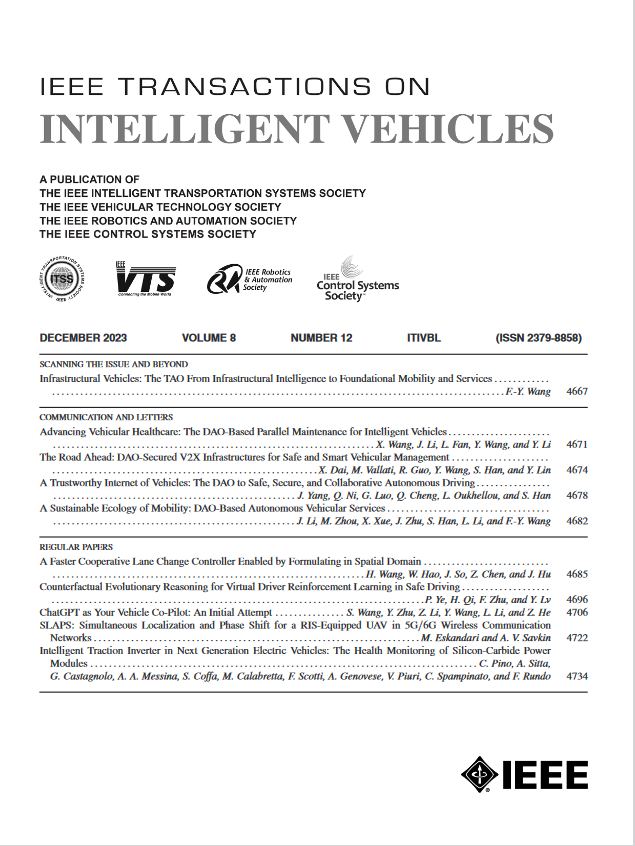Enhancing Safety in Nonlinear Systems: Design and Stability Analysis of Adaptive Cruise Control
IF 14
1区 工程技术
Q1 COMPUTER SCIENCE, ARTIFICIAL INTELLIGENCE
引用次数: 0
Abstract
The safety of autonomous driving systems, particularly self-driving vehicles, remains of paramount concern. These systems exhibit affine nonlinear dynamics and face the challenge of executing predefined control tasks while adhering to state and input constraints to mitigate risks. However, achieving safety control within the framework of control input constraints, such as collision avoidance and maintaining system states within secure boundaries, presents challenges due to limited options. In this article, we introduce a novel approach to address safety concerns by transforming safety conditions into control constraints with a relative degree of 1. This transformation is facilitated through the design of control barrier functions, enabling the creation of a safety control system for affine nonlinear networks. Subsequently, we formulate a robust control strategy that incorporates safety protocols and conduct a comprehensive analysis of its stability and reliability. To illustrate the effectiveness of our approach, we apply it to a specific problem involving adaptive cruise control. Through simulations, we validate the efficiency of our model in ensuring safety without compromising control performance. Our approach signifies significant progress in the field, providing a practical solution to enhance safety for autonomous driving systems operating within the context of affine nonlinear dynamics.提高非线性系统的安全性:自适应巡航控制的设计与稳定性分析
自动驾驶系统的安全性,尤其是自动驾驶汽车的安全性,仍然是人们最关心的问题。这些系统表现出仿射非线性动力学,在遵守状态和输入约束以降低风险的同时,面临着执行预定义控制任务的挑战。然而,在控制输入约束的框架内实现安全控制,如避免碰撞和保持系统状态在安全边界内,由于选择有限,提出了挑战。在本文中,我们介绍了一种通过将安全条件转换为相对程度为1的控制约束来解决安全问题的新方法。通过控制屏障函数的设计促进了这种转换,从而能够创建仿射非线性网络的安全控制系统。随后,我们制定了一个包含安全协议的鲁棒控制策略,并对其稳定性和可靠性进行了全面分析。为了说明我们的方法的有效性,我们将其应用于一个涉及自适应巡航控制的特定问题。通过仿真,我们验证了该模型在不影响控制性能的情况下确保安全的有效性。我们的方法在该领域取得了重大进展,为提高仿射非线性动力学环境下自动驾驶系统的安全性提供了切实可行的解决方案。
本文章由计算机程序翻译,如有差异,请以英文原文为准。
求助全文
约1分钟内获得全文
求助全文
来源期刊

IEEE Transactions on Intelligent Vehicles
Mathematics-Control and Optimization
CiteScore
12.10
自引率
13.40%
发文量
177
期刊介绍:
The IEEE Transactions on Intelligent Vehicles (T-IV) is a premier platform for publishing peer-reviewed articles that present innovative research concepts, application results, significant theoretical findings, and application case studies in the field of intelligent vehicles. With a particular emphasis on automated vehicles within roadway environments, T-IV aims to raise awareness of pressing research and application challenges.
Our focus is on providing critical information to the intelligent vehicle community, serving as a dissemination vehicle for IEEE ITS Society members and others interested in learning about the state-of-the-art developments and progress in research and applications related to intelligent vehicles. Join us in advancing knowledge and innovation in this dynamic field.
 求助内容:
求助内容: 应助结果提醒方式:
应助结果提醒方式:


